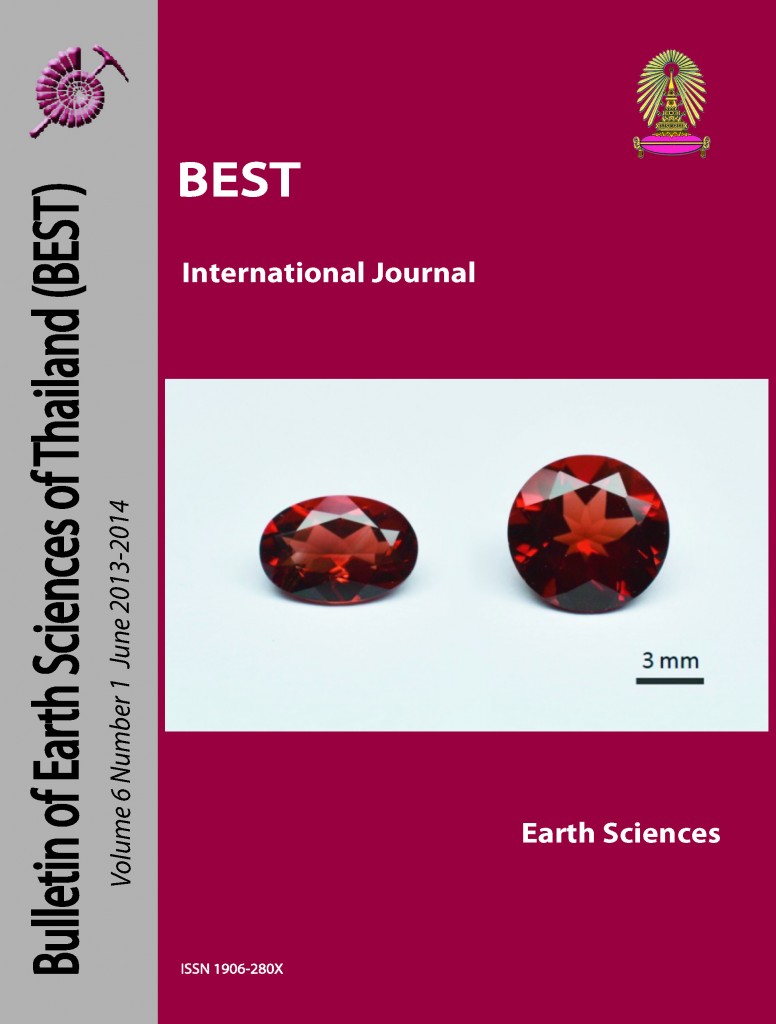Earthquake Activities along the Ranong-Klong Marui Fault Zone, Southern Thailand: Implication from the Seismicity Data
Main Article Content
Abstract
In this study, the earthquake activities along the Ranong-Klong Marui Fault Zone (RKFZ) are investigated using the power law of earthquake frequency-magnitude distribution (FMD). The possible maximum magnitudes, recurrence periods, including the probabilities of earthquake occurrences are determined according to the constant a- and b-values obtained from the FMD. The results reveal that the RKFZ has a potential to generate the earthquake with 6.3 and 6.9 Mw in the next 50 and 100 years. Meanwhile, the Mw-7.4 earthquake proposed previously as the maximum credible earthquake has the return period around 230 year. Moreover, for the probabilities of the Mw-7.4 occurrences in the next 10, 25, 50, and 100 years, this study concludes that there are around 4, 10, 20, and 36%, respectively.
Article Details

This work is licensed under a Creative Commons Attribution-NonCommercial-NoDerivatives 4.0 International License.
Copyright © 2008 Department of Geology, Faculty of Science, Chulalongkorn University. Parts of an article can be photocopied or reproduced without prior written permission from the author(s), but due acknowledgments should be stated or cited accordingly.
References
Gardner, J.K., Knopoff, L., 1974. Is the sequence of earthquakes in Southern California, with aftershocks removed, Poissonian?. Bulletin of the Seismological Society of America; 64(1), 363–367.
Gutenberg, B., Richter, C.F., 1944. Frequency of earthquakes in California. Bulletin of the Seismological Society of America; 34, 185-188.
Ishimoto M., Iida, K., 1939. Observations of earthquakes registered with the microseismograph constructed recently. Bulletin of the Earthquake Research Institute, University of Tokyo; 17, 443-478.
Kaewmuangmoon, S., Thipyupas, S., Kosuwan, S., Daorerk, V., Charusiri, P., 2008. Investigations on Tectonic Geomorphology along the Khlong Marui Fault, Kao Phanom area, Southern Thailand: Application of ArcGIS Approach. Proceedings of the International Symposia on Geoscience Resources and Environments of Asian Terranes (GREAT 2008), 4th IGCP 516, and 5th APSEG, November 24-26, 2008, Bangkok, Thailand, pp.126-129.
Palasri, C., Ruangrassamee, A., 2010. Probabilistic Seismic Hazard Maps of Thailand. Journal of Earthquake and Tsunami; 4(4), 369–386.
Pailoplee, S., 2012. Is the Ranong-Klong Marui Fault Zone Active? -Implication from the Definition of Active Fault. Civil Engineering Magazine; January-March 2012, 33-41. (in Thai)
Pailoplee, S., Sugiyama, Y., Charusiri, P., 2009. Deterministic and probabilistic seismic hazard analyses in Thailand and adjacent areas using active fault data. Earth, Planets and Space; 61, 1313-1325.
Thipyupas, S., 2009. Preliminary Macroseismic Investigation at Prajuabkirikhan in September-October 2006. Geographic Journal; 33(2), p.64-85. (in Thai)
Thipyupas, S., 2010. Paleo-earthquake Investigation along the Ranong Fault Zone, Southern Thailand. M.Sc. Thesis, Department of Geology, Faculty of Science, Chulalongkorn University, Bangkok, Thailand, 316p.
Thipyupas, S., Hanpattanapanich, T., Pailoplee, S., Charusiri, P., 2012. Is Ranong fault in southern Thailand active? - Evidence from seismological, paleoseismological, and seismic investigations. The 12th GEOSEA 2012, Bangkok, Thailand, p.78. (Abstract)
Wells, D.L., Coppersmith, K.J., 1994. Updated empirical relationships among magnitude, rupture length, rupture area, and surface displacement. Bulletin of the Seismological Society of America; 84, 974-1002.
Wiemer, S., 2001. A software package to analyze seismicity: ZMAP. Seismological Research Letters; 72, 373-382.
Woessner, J., Wiemer, S., 2005. Assessing the Quality of Earthquake Catalogues: Estimating the Magnitude of Completeness and Its Uncertainty. Bulletin of the Seismological Society of America; 95(2), 684-698.
Yadav, R.B.S., Tripathi, J.N., Shanker, D., Rastogi, B.K., Das, M.C., Kumar, V., 2011. Probabilities for the occurrences of medium to large earthquakes in northeast India and adjoining region. Natural Hazards; 56, 145-167.
Youngs, R.R., Coppersmith, K.J., 1985. Implications of fault slip rates and earthquake recurrence models to probabilistic seismic hazard estimates. Bulletin of the Seismological Society of America; 75, 939-964.


